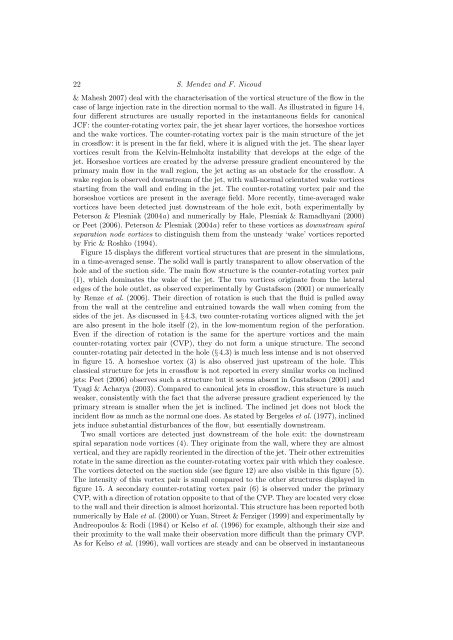these simulation numerique et modelisation de l'ecoulement autour ...
these simulation numerique et modelisation de l'ecoulement autour ...
these simulation numerique et modelisation de l'ecoulement autour ...
You also want an ePaper? Increase the reach of your titles
YUMPU automatically turns print PDFs into web optimized ePapers that Google loves.
22 S. Men<strong>de</strong>z and F. Nicoud<br />
& Mahesh 2007) <strong>de</strong>al with the characterisation of the vortical structure of the flow in the<br />
case of large injection rate in the direction normal to the wall. As illustrated in figure 14,<br />
four different structures are usually reported in the instantaneous fields for canonical<br />
JCF: the counter-rotating vortex pair, the j<strong>et</strong> shear layer vortices, the horseshoe vortices<br />
and the wake vortices. The counter-rotating vortex pair is the main structure of the j<strong>et</strong><br />
in crossflow: it is present in the far field, where it is aligned with the j<strong>et</strong>. The shear layer<br />
vortices result from the Kelvin-Helmholtz instability that <strong>de</strong>velops at the edge of the<br />
j<strong>et</strong>. Horseshoe vortices are created by the adverse pressure gradient encountered by the<br />
primary main flow in the wall region, the j<strong>et</strong> acting as an obstacle for the crossflow. A<br />
wake region is observed downstream of the j<strong>et</strong>, with wall-normal orientated wake vortices<br />
starting from the wall and ending in the j<strong>et</strong>. The counter-rotating vortex pair and the<br />
horseshoe vortices are present in the average field. More recently, time-averaged wake<br />
vortices have been d<strong>et</strong>ected just downstream of the hole exit, both experimentally by<br />
P<strong>et</strong>erson & Plesniak (2004a) and numerically by Hale, Plesniak & Ramadhyani (2000)<br />
or Pe<strong>et</strong> (2006). P<strong>et</strong>erson & Plesniak (2004a) refer to <strong>these</strong> vortices as downstream spiral<br />
separation no<strong>de</strong> vortices to distinguish them from the unsteady ‘wake’ vortices reported<br />
by Fric & Roshko (1994).<br />
Figure 15 displays the different vortical structures that are present in the <strong>simulation</strong>s,<br />
in a time-averaged sense. The solid wall is partly transparent to allow observation of the<br />
hole and of the suction si<strong>de</strong>. The main flow structure is the counter-rotating vortex pair<br />
(1), which dominates the wake of the j<strong>et</strong>. The two vortices originate from the lateral<br />
edges of the hole outl<strong>et</strong>, as observed experimentally by Gustafsson (2001) or numerically<br />
by Renze <strong>et</strong> al. (2006). Their direction of rotation is such that the fluid is pulled away<br />
from the wall at the centreline and entrained towards the wall when coming from the<br />
si<strong>de</strong>s of the j<strong>et</strong>. As discussed in §4.3, two counter-rotating vortices aligned with the j<strong>et</strong><br />
are also present in the hole itself (2), in the low-momentum region of the perforation.<br />
Even if the direction of rotation is the same for the aperture vortices and the main<br />
counter-rotating vortex pair (CVP), they do not form a unique structure. The second<br />
counter-rotating pair d<strong>et</strong>ected in the hole (§ 4.3) is much less intense and is not observed<br />
in figure 15. A horseshoe vortex (3) is also observed just upstream of the hole. This<br />
classical structure for j<strong>et</strong>s in crossflow is not reported in every similar works on inclined<br />
j<strong>et</strong>s: Pe<strong>et</strong> (2006) observes such a structure but it seems absent in Gustafsson (2001) and<br />
Tyagi & Acharya (2003). Compared to canonical j<strong>et</strong>s in crossflow, this structure is much<br />
weaker, consistently with the fact that the adverse pressure gradient experienced by the<br />
primary stream is smaller when the j<strong>et</strong> is inclined. The inclined j<strong>et</strong> does not block the<br />
inci<strong>de</strong>nt flow as much as the normal one does. As stated by Bergeles <strong>et</strong> al. (1977), inclined<br />
j<strong>et</strong>s induce substantial disturbances of the flow, but essentially downstream.<br />
Two small vortices are d<strong>et</strong>ected just downstream of the hole exit: the downstream<br />
spiral separation no<strong>de</strong> vortices (4). They originate from the wall, where they are almost<br />
vertical, and they are rapidly reoriented in the direction of the j<strong>et</strong>. Their other extremities<br />
rotate in the same direction as the counter-rotating vortex pair with which they coalesce.<br />
The vortices d<strong>et</strong>ected on the suction si<strong>de</strong> (see figure 12) are also visible in this figure (5).<br />
The intensity of this vortex pair is small compared to the other structures displayed in<br />
figure 15. A secondary counter-rotating vortex pair (6) is observed un<strong>de</strong>r the primary<br />
CVP, with a direction of rotation opposite to that of the CVP. They are located very close<br />
to the wall and their direction is almost horizontal. This structure has been reported both<br />
numerically by Hale <strong>et</strong> al. (2000) or Yuan, Stre<strong>et</strong> & Ferziger (1999) and experimentally by<br />
Andreopoulos & Rodi (1984) or Kelso <strong>et</strong> al. (1996) for example, although their size and<br />
their proximity to the wall make their observation more difficult than the primary CVP.<br />
As for Kelso <strong>et</strong> al. (1996), wall vortices are steady and can be observed in instantaneous

















